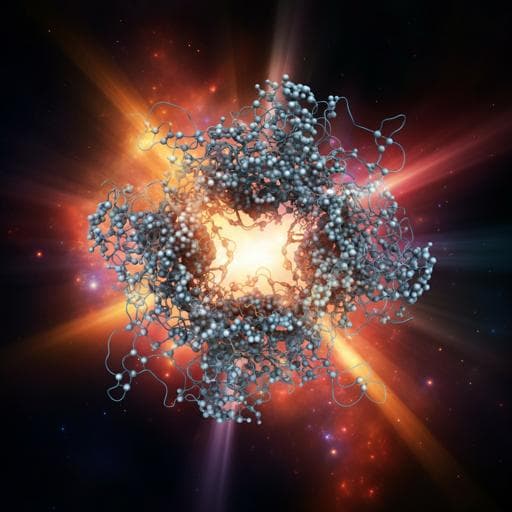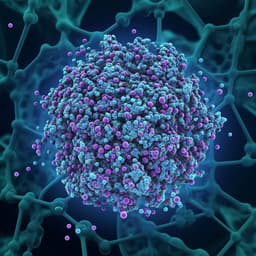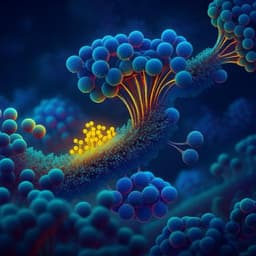
Chemistry
Visible-light-mediated catalyst-free synthesis of unnatural α-amino acids and peptide macrocycles
M. Wang, C. Wang, et al.
Discover a groundbreaking catalyst-free approach for synthesizing unnatural α-amino acids and peptide macrocycles using visible light! This innovative method leverages the unique properties of Katritzky salts, unlocking new pathways for deaminative hydroalkylation and cyclization, as revealed by the research conducted by Mengran Wang, Chao Wang, Yumei Huo, Xiaobo Dang, Hongxiang Xue, Liangyu Liu, Hongli Chai, Xiuling Xie, Zhixuan Li, Doudou Lu, and Zhaoqing Xu.
~3 min • Beginner • English
Introduction
Peptide therapeutics offer high affinity and selectivity for diverse biological targets but suffer from poor membrane permeability, metabolic stability, and bioavailability. Strategies to overcome these issues include incorporation of unnatural amino acids (UAAs) and macrocyclization. Visible-light photochemistry has emerged as a mild, functional-group-tolerant platform for selective biomolecule modification, enabling transformations of amino acids, peptides, and proteins. Dehydroalanine (Dha), a naturally occurring and readily accessible dehydroamino acid, serves as a versatile handle for UAA synthesis; however, access to β-alkyl-substituted UAAs remains limited and typically relies on transition metals or stoichiometric metals. Compatible methods for Dha modification within peptides, particularly for macrocyclization via Dha functionalization, are scarce. Primary amines are abundant precursors for alkyl radicals via deaminative strategies using Katritzky salts. The study aims to develop a visible-light-mediated, catalyst-free approach where ionic compounds promote homolytic cleavage of pyridinium C–N bonds in Katritzky salts to generate alkyl radicals for deaminative hydroalkylation of alkenes (including Dha) and to enable N-terminal peptide macrocyclization. The approach leverages Et3N or PPh3 as single-electron reductants and water as a hydrogen source.
Literature Review
Prior work established visible-light photoredox catalysis as a powerful bond-forming strategy under mild conditions with high functional group tolerance (e.g., MacMillan’s decarboxylative Giese reactions for peptide macrocyclization). Dha has been widely used to access UAAs, yet β-alkyl substituted UAAs often require transition-metal catalysis or stoichiometric metals. Deaminative radical generation from primary amines via Katritzky salts and EDA complexes has enabled catalyst-free functionalizations but typically relies on specific electron donors (e.g., Hantzsch esters, indoles) to form photoactive EDA aggregates. Photochemical peptide macrocyclization strategies often depend on transition metals or decarboxylative activation at the C-terminus. There is a gap for catalyst-free, visible-light methods that directly cleave pyridinium C–N bonds and are compatible with Dha residues in peptides for both modification and N-terminal macrocyclization.
Methodology
Two operationally simple, photocatalyst-free conditions were developed, each employing an ionic additive to promote visible-light absorption of the pyridinium salt and a single-electron reductant (SER). Irradiation was conducted with violet LEDs at room temperature under argon.
- Condition A: Alkene (0.2 mmol), alkyl pyridinium salt (2.5 equiv), Et3N (2.0 equiv), K2CO3 (1.0 equiv), H2O (30 equiv), CH3CN (3 mL); 24 W, 410–420 nm; 12 h. Workup by aqueous quench, extraction, and column chromatography.
- Condition B: Alkene (0.2 mmol), alkyl pyridinium salt (2.0 equiv), PPh3 (2.4 equiv), KOCH3 (3.0 equiv), H2O (25 equiv), acetone (3 mL); 24 W, 420–430 nm; 12 h. Standard workup and purification as above.
Condition screening (Table 1) assessed the impact of bases (K2CO3, KOCH3, fluoride salts), presence/absence of SER (Et3N or PPh3), water, and light. UV–Vis measurements showed that basic ionic additives (K2CO3, KOCH3, CsF, etc.) markedly enhance visible-light absorption (400–480 nm) of the pyridinium substrate, enabling C–N bond homolysis.
Substrate scope studies:
- Michael acceptors: Dha methyl ester and related dehydroamino acids, diethyl fumarate, vinyl sulfones, malonate-derived alkenes, and amide-bearing acceptors furnished hydroalkylation products in good to excellent yields. β-Thiolated amino acid derivatives (from L-Cys) and a Dha-derived Karady–Beckwith alkene also participated, delivering products with defined rotamer/diastereomer ratios.
- Katritzky salts: A broad range of secondary alkyl pyridiniums and a glycine-derived pyridinium provided products in moderate to excellent yields under both conditions. More complex substrates bearing diverse functional groups were compatible. Unactivated primary alkyl substrates failed due to competing radical–radical coupling.
Peptide applications:
- Dha-containing peptides incorporating residues such as Gly, Pro, Leu, Trp, Phe, and Tyr underwent site-selective deaminative conjugation to give adducts (typically 76–95% yields), leaving other residues intact.
- N-terminal macrocyclization: Linear peptides bearing Dha were cyclized via deaminative radical addition, affording macrocycles in 28–40% isolated yields after HPLC. On-resin macrocyclization attempts failed.
Mechanistic experiments:
- Radical trapping (e.g., TEMPO) supported alkyl radical formation upon visible-light irradiation in the presence of ionic additives.
- Isotope labeling: Replacing H2O with D2O furnished deuterated products (e.g., 5a-D 86% in condition A; 7a-D 34% in condition B), indicating water as the proton (hydrogen) source.
- Observation of stoichiometric Ph3PO under condition B supports a stepwise two-electron donation by PPh3 (via a phosphine radical cation and subsequent oxidation to Ph3PO).
- UV–Vis: Pyridinium salts alone or with Et3N/PPh3 showed little absorption >400 nm; addition of K2CO3 or KOCH3 dramatically increased absorption in the visible region. A slight bathochromic shift was observed for [Et3N+ pyridinium], consistent with a weak EDA interaction.
Proposed mechanism: Visible light in the presence of basic ionic compounds induces homolytic C–N cleavage of the Katritzky salt to form an alkyl radical and a pyridinium radical cation. The SER (Et3N or PPh3) is oxidized to a radical cation; under condition A, the amine radical cation is deprotonated to an α-amino radical that reduces the intermediate; under condition B, the phosphine radical cation reacts with H2O to generate a species that donates a second electron, culminating in Ph3PO. Radical addition to the Michael acceptor affords a radical intermediate that is reduced to a carbanion and then protonated to yield the hydroalkylation product. An EDA pathway cannot be definitively excluded.
Key Findings
- Ionic additives (e.g., K2CO3, KOCH3, CsF) dramatically increase visible-light absorption (400–480 nm) of alkyl pyridinium salts, enabling photocatalyst-free C–N bond homolysis and alkyl radical generation.
- Optimal conditions:
• Condition A (Et3N/K2CO3/H2O, MeCN, 410–420 nm) delivered 5a in 97% NMR yield (94% isolated).
• Condition B (PPh3/KOCH3/H2O, acetone, 420–430 nm) delivered 5a in 88% NMR yield (84% isolated).
- Controls (Table 1): Removing base reduced yields substantially (e.g., to 50% without K2CO3 under A; 13% without KOCH3 under B). Fluoride additives improved outcomes (KF 63% under A; CsF 41% under B). No SER gave only trace product; no H2O led to ≤54% yield; no light or heating without light gave no reaction.
- Alkene scope (Fig. 2a): Diverse Michael acceptors furnished products in good to excellent yields (e.g., dehydrobutyrine 5b 80% A/76% B, 4:1 d.r.; diethyl fumarate 5d 95% A/86% B; amide-bearing acceptors 5f–5j up to 95% yield). β-Thiolated derivatives afforded products with good rotamer/diastereomer control (e.g., 5k 80% with 5.7:1 r.r.; 5l 95% >20:1 d.r.).
- Katritzky salt scope (Fig. 2b): Secondary alkyl pyridiniums 7a–7h up to 92% yield; glycine-derived pyridinium 7h: 92% (A) and 85% (B). Complex substrates 7i–7r gave moderate to excellent yields. Unactivated primary alkyl substrates failed due to radical–radical coupling side reactions.
- Peptide functionalization (Fig. 3a): Dha-containing peptides with Gly, Pro, Leu, Trp, Phe, Tyr residues yielded adducts 9a–9i in 76–95% (often with defined d.r.). Other residues were unmodified.
- Macrocyclization (Fig. 3b): N-terminal deaminative macrocyclization furnished macrocyclic peptides 11a–11e in 28–40% isolated yields. On-resin cyclization attempts were unsuccessful.
- Mechanistic evidence: Radical trapping detected adducts consistent with alkyl radical formation. D2O incorporation confirmed H2O as H-source (e.g., 5a-D 86% under A; 7a-D 34% under B). Stoichiometric Ph3PO formation indicates PPh3 donates two electrons in a stepwise manner. UV–Vis spectra corroborate ionic additive–enabled visible-light absorption of pyridinium salts.
Discussion
The study addresses the challenge of generating alkyl radicals from Katritzky salts under visible light without photocatalysts or specific EDA donor partners. By employing basic ionic additives to enhance visible absorption, the method directly homolyzes pyridinium C–N bonds, enabling efficient deaminative hydroalkylation of electron-deficient alkenes, including Dha-containing motifs. This expands access to β-alkyl-substituted UAAs under mild, catalyst-free conditions compatible with peptide settings. The ability to functionalize Dha within peptides across diverse sequences and to effect N-terminal macrocyclization demonstrates chemoselectivity and synthetic utility for peptide modification and drug discovery. Mechanistic experiments are consistent with additive-enabled photochemistry and SER-mediated reductions (Et3N or PPh3/H2O), although an EDA pathway cannot be fully excluded. Overall, the results validate the concept that simple ionic compounds can harness visible light to promote radical generation from Katritzky salts, broadening the photochemical toolbox for amino acid and peptide synthesis.
Conclusion
Ionic compounds can promote visible-light-induced homolytic cleavage of pyridinium C–N bonds, obviating photocatalysts and enabling deaminative hydroalkylation of a broad set of alkenes, notably Dha, to furnish β-alkyl-substituted unnatural α-amino acids under mild conditions. The platform is compatible with complex peptides, allowing site-selective Dha modification and N-terminal peptide macrocyclization. Practical features include the use of Et3N or PPh3 as reductants and H2O as the hydrogen source. Future work will elucidate the precise mechanism of ionic-additive-enhanced visible absorption and extend the methodology to additional transformations and on-resin peptide macrocyclizations.
Limitations
- The exact mechanistic origin of ionic additive–enhanced visible-light absorption remains unresolved; an EDA pathway cannot be completely ruled out.
- Unactivated primary alkyl substrates failed due to radical–radical coupling side reactions.
- Macrocyclization yields are moderate (28–40%) and attempts at on-resin macrocyclization were unsuccessful.
- Some ionic additives that increased absorption (e.g., Cs2CO3, K3PO4, NaOCH3) afforded only moderate yields, indicating complex additive effects beyond absorption enhancement.
Related Publications
Explore these studies to deepen your understanding of the subject.







